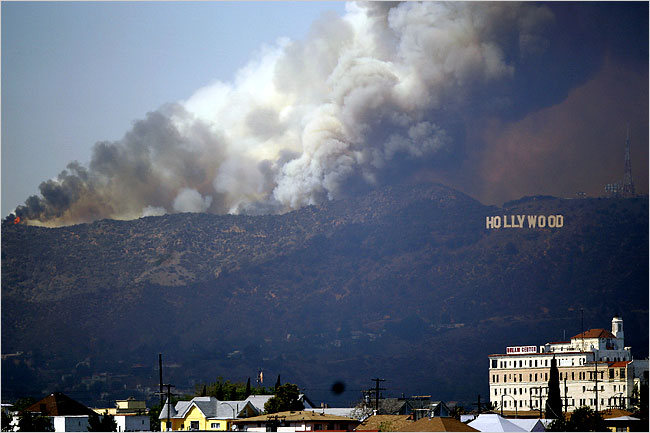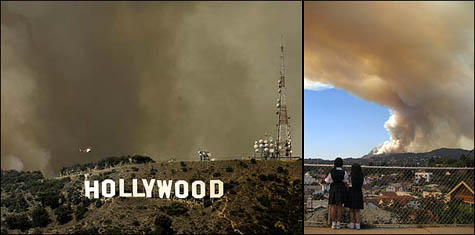 [Image: Photo by Kim Johnson Flodin/Associated Press, via the New York Times].
[Image: Photo by Kim Johnson Flodin/Associated Press, via the New York Times].
Not being a local news follower, I found myself sitting outside yesterday afternoon in Los Angeles, beneath a huge brown cloud that seemed to hover there, more or less stationary, above the parking lot beside me. The cloud was totally alone, surrounded on all sides by perfectly blue sky, as if a thunderstorm had rolled in only to change its mind and drift off, leaving part of itself behind, atmospherically orphaned in the sunlight. After all, there was no rain.
The cloud didn’t appear to be moving.
I began expecting an earthquake.
“Is there a fire or something?” I asked a guy wearing sunglasses as he walked past me on the sidewalk – but it occurred to me, absurdly, even as I heard myself asking him the question, that perhaps the cloud would be impossible to see through his sunglasses: its color would be visually filtered out by the glass’s tint and so he wouldn’t even know what I was talking about.
Instead, he just nodded and said, “Uh huh,” walking off past Radio Shack.
Still detached from the local news cycle at that point, and beginning to notice that not a single other person was looking up into the sky at what seemed, at least to me, to be a very obvious and possibly threatening brown cloud, I decided that people here really must be so over-trustful of the world that even a menacing, oily blur hovering above their heads could simply be perceptually filed away as some weird but harmless fluke: it’ll go away – it won’t be here tomorrow – and you can therefore just forget it ever happened…
Don’t think about it and it won’t harm you.
Which is when I remembered something called the “airborne toxic event” from Don DeLillo’s novel White Noise.
About a third of the way through that book, there is a train derailment somewhere outside a small American college town. The accident releases a toxic cloud into the sky: “the smoke was plainly visible,” we read, “a heavy black mass hanging in the air beyond the river, more or less shapeless.”
One of the characters says it resembles “a shapeless growing thing. A dark black breathing thing of smoke.”
Families close to the accident are soon asked to evacuate – “Abandon all domiciles,” an amplified voice calls out, broadcast from a truck that drives through the cul-de-sacs – while “medical problems” that might develop upon “personal contact with the airborne toxic event” are discussed on the radio.
One of these problems is apparently déjà vu.
The source of the cloud, meanwhile, is being buried by snow machines, in the weird hope that this will thermo-chemically contain its spread; and so an artificial winter begins to erupt as rogue flakes blow on contaminated winds through the suburbs. Etc. etc. It’s all very ironic and surreal.
At one point, though, the drifting cloud becomes an all-out military spectacle:
A few minutes later, back on the road, we saw a remarkable and startling sight. It appeared in the sky ahead of us and to the left, prompting us to lower ourselves in our seats, bend our heads for a clearer view, exclaim to each other in half finished phrases. It was the black billowing cloud, the airborne toxic event, lighted by the clear beams of seven army helicopters. They were tracking its windborne movement, keeping it in view. In every car, heads shifted, drivers blew their horns to alert others, faces appeared in side windows, expressions set in tones of outlandish wonderment.
The enormous dark mass moved like some death ship in a Norse legend, escorted across the night by armored creatures with spiral wings. We weren’t sure how to react.
To find out what happens next, both to the cloud and to the people watching it, you’ll just have to read the book; but, returning to a bench in Los Angeles yesterday on top of which I sat, looking up at an oily blur that seemed oddly rooted in place there above a parking lot, with no one else visibly concerned, no one else appearing to wonder what on earth it was that had come to visit us that day, there in the atmosphere, shadowing us, I was sad to learn that the whole thing was just the downwind result of a fire in the Hollywood Hills – an event I had otherwise managed to miss seeing entirely.
 [Images: Via the BBC].
[Images: Via the BBC].
So much for the sublime or the inexplicable or the mysterious. I went back to reading, and the cloud blew away.
Amazing conceptual idea behind this work, a real testament of our machines as extensions of our senses. The idea of space was so different before the lunar landing, before Hubble. All of sudden something seemingly innocuous, now dangerous, or the opposite can happen. Always finding your blog interesting, thanks!